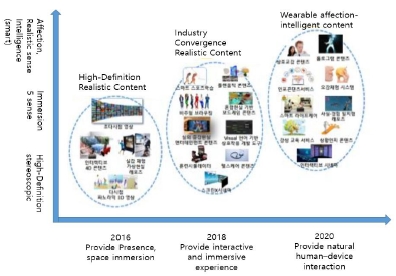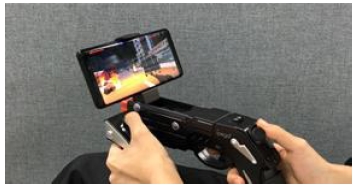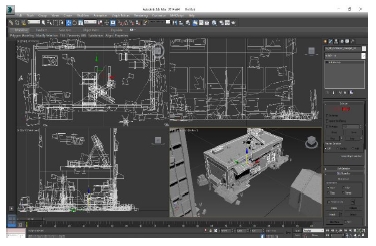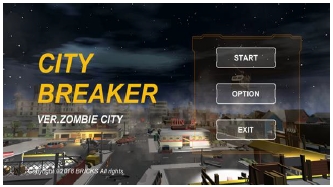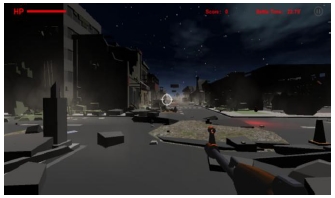
Implementation of Realistic Contents with a ARgun Device
Copyright ⓒ 2018 The Digital Contents Society
This is an Open Access article distributed under the terms of the Creative Commons Attribution Non-CommercialLicense(http://creativecommons.org/licenses/by-nc/3.0/) which permits unrestricted non-commercial use, distribution, and reproduction in any medium, provided the original work is properly cited.

Abstract
Recently, Many realistic game contents based on VR(Virtual Reality) and AR(Augmented Reality) have been developed. However, in the content planning stage, it is often the case that the content is produced empirically rather than analyzing the content itself. If this happens, there is a high probability of failure in the market. The purpose of this paper is to develop realistic 3D horror games by analyzing the factors of fear. Horror game content is produced by applying environmental factors that elicit fear from the atmosphere, excluding the disgust resulting from the existing visual discomfort. The result is the most popular FPS(First Person Shooter) type game, running on both PC and mobile platform. In order to make the contents more fearful, realistic device called ARgun is applied.
초록
최근 VR(Virtual Reality)과 AR(Augmented Reality)을 기반으로 하는 실감형 게임콘텐츠가 많이 개발되고 있다. 그러나 콘텐츠 기획단계에서 콘텐츠 자체에 대한 분석을 하기 보다는 경험적으로 콘텐츠를 제작하는 경우가 많다. 이럴 경우 시장에서 실패할 확률이 크다. 본 논문은 공포를 느끼는 요인을 분석하고 그 결과를 적용하여 실감형 3D 공포게임을 개발하는 것을 목표로 하고 있다. 공포를 유발하는 여러 가지 요인들 중 기존의 시각적인 불쾌감으로부터 오는 혐오감은 배제하고 분위기로부터 공포를 자아내게 만드는 환경적인 요인을 적용하여 공포게임 콘텐츠를 제작하고자 한다. 결과로 PC 와 모바일 기반에서 운영되며 제일 인기 많은 FPS(First Person Shooter)형 게임을 작성한다. 또한 제작한 콘텐츠를 더욱 무섭게 느끼기 위하여 ARgun이라는 실감형 디바이스를 적용한다.
Keywords:
A realistic user interface, ARgun, Fear factor, 3D horror game키워드:
실감형 사용자 인터페이스, ARgun, 공포요인, 3D 공포게임Ⅰ. Introduction
According to a report by the Software Policy Research Institute, big data analysis and survey results show that the top six software issues that are emerging in 2019 include realistic software[1]. Especially businesses and telecommunication businesses are showing the most interest in tangible game contents that are linked to VR/AR (Virtual/Augmented Reality). It is predicting that paradigm of real-world E-Sports is being changed through VR technology and size of global real-world software markets will grow by 10 times by 2020 with 75.9% per year. Realistic software means a software that fully utilizes human senses and reacts to any user's actions in real time. It is an industrial field that collectively refers to fields of realistic content and media production, transmission, and processing technologies that maximize user immersion and presence, and is emerging as a cutting-edge convergence industry that encompasses the future broadcasting communication and content industries.
This is a paper for producing realistic contents based on psychological factors and for connecting with a realistic device for the interface.
This paper is composed of the following. Chapter 2 explains horror psychology analysis, and Chapter 3 explains tangible user interface for realistic experience and a ARgun for this paper. Chapter 4 shows the process of implementing a horror game using ARGun, and Chapter 5 consists of future research and conclusion.
Ⅱ. Fear Psychological Analysis
In academia, much research has been done on exactly what is happening in our brains when we see or experience something horrible, and game designers are making use of these achievements in their own games. According to Andrew Weaver, an associate professor at Indiana University and a researcher on media consumption psychology, "The psychological response to an astonishing stimulus does not differ greatly depending on whether it is the source of the stimulus or the media.”[2].
From the standpoint of viewers, humans use the "suspension of disbelief" mechanism very well. By voluntarily forgetting that things we see or enjoy are not facts, we become more fully immersed in the story of the media. If this commitment is made, we will have a strong bond with the characters in the story, we also feel the fear we experience. So, in this project, we embody frightening and fears through the psychology of fear through examples of various movies and successful game examples.
2.1 Case study of popular horror games
The rankings were selected on the theme of 'The Best Psychological Horror Games of All Time' at the online evaluation site 'Ranker'[3]. This is a list of the best psychological horror games of all time for any console or system, including cover art pictures when available. These highly rated psychological horror games are ordered by popularity, so only the greatest psychological horror games are at the top of the list. Spanning the entire history of the genre, these psychological horror games are considered the best in the genre. This list includes all challenging psychological horror games that have ever hit the shelves, so it doesn't necessarily have all the more obscure or new psychological horror games[4]. The list you're viewing is made up of different fun psychological horror games like Dead Space and Silent Hill. We looked at four of the most popular games.
The following Table 1. summarizes the features of Top 4's popular horror game and explains the factors that increased fear[5].
2.2 Implementation Factors for Fear environment
Much has been said about the psychological implications of the player's 'self' expanding into the avatars in the game, and these issues are particularly relevant to the Psychological horror genre.
Psychological horror is a sub-genre of fear and psychological fictitiousness that depends on the psychological state, which astonishes, interferes with, or releases readers and viewers. The sub-genre often overlaps with subtle parts of the psychological thriller and provides an unpleasant and confusing situation using psychological states such as anxious, unstable or uneasy psychological states and fear, play, and fear. In it, fright is created between tight tension, and fear comes into conflict with the psychology of an individual who does not want to be alarmed. I have planned the game through this psychological fear and the preceding example.
'Silent Hill' frees up fog and darkness to confuse the player. 'Amnesia: The Dark Descent is also constructed in such a way as to explore dark castles and avoid enemies. Through these cases, planned to play the game in a dark space in a thick mist. Also inspired by the night vision mode used in 'Outlast', we designed a space where the player could see the enemy well by using the item called streetlight every distance. These factors make the game more fun by adding psychological pressure to find a bright spot quickly in tight tension. In addition, unlike other games, the background music is minimized in the dark, and the enemy player's footsteps and the sound of distant sounds are used to detect where the player is, and the more the sound gets closer, the more fear is amplified.
When attacking the enemy body in the dead space, attack efficiency is applied differently depending on the region. For example, firing most of the ‘Necromorphs’ in your head has little effect, but may stop when the player removes his or her arms and legs. This game also applies different attack power to the enemy's body, so that it can kill enemies faster than attacking other parts when attacking the head. This will add to the sense of pressure that you have to align your head in fear, and you will be able to play the game more fun.
Ⅲ. Tangible interface for a realistic contents
3.1 Trends of tangible interface for a realistic contents
A user interface that is similar to human gesture is needed to produce realistic contents. While there is a high possibility that real contents will be activated through development of VR/AR, technology that can naturally interact with contents under VR/AR environment is needed to further develop. The following Fig. 1 illustrates a realistic content concept diagram and representative services[6].
As E-sports were activated recently, experimental sports contents based on virtual reality have been developed that is, a person’s movements can be inputted into sensors to deliver information. Examples include shooting experience simulators, golf, and snowboard.
3.2 Realistic game using ARgun
Currently, the game industry is growing remarkably. The development of the game industry has been steadily rising due to the spread of smart phones, the distribution of games and the proliferation of consumer companies. Among them, mobile games occupy a very high proportion. While platforms such as online games and PC games are showing a downward trend, mobile games are showing a steady upward trend. Looking at the growth rate of mobile games over the last four years, we can see that it has risen by more than 20%[7]. Game companies are driving the popularity of online games to the launch of mobile games. PUBG's 'Battlegrounds', which has been popular recently, has succeeded in launching mobile games. 'Battlegrounds' is a form of FPS game (First Person Shooting Game), and the popularity of FPS games in the game market is guaranteed to be steady and long-term. In addition to this game, 'Overwatch' and 'Sudden Attack' are examples of steadily popular FPS games[8].
Based on the flow of the game market, we decided on the theme and story of the game. With the topic of FPS games with a high success rate in the game market, we have devised a way to enjoy immersive and lively games when users play FPS games. Instead of just using the weapons on the screen of the game, we were able to investigate devices for realizing the game with real game devices. We noticed that various devices such as a Bluetooth joystick and an adsorption function key are being released. However, in order to enjoy the FPS game more realistically, it was judged that a device which looked like a real gun would be suitable. In Korea, we have chosen 'ARgun', a non-standard device. 'ARgun' is similar to a real gun. When you pull the trigger, you can fire the bullet on the screen and you can feel the gun shake when the bullet is fired by the vibration effect. Users who use this device feel like they are playing games using guns rather than on the screen. The game provides players with an experience of simulating into the real world[9].
Ⅳ. Realistic Contents Implementation
4.1 Implementation of 3D graphic Modeling
In this game, the psychological factors that cause fear are emphasized collectively by fright and the creation of a dreadful atmosphere. In order to maximize fear when encountering enemies that suddenly appear anywhere and anytime, they must narrow their observable perspectives. Also, when nothing is visible, the eerie noise of the enemy can further maximize their fear. These two factors have been applied to implement games in Unity. The background is to model a devastating environment in which enemies can suddenly appear anywhere to create fear. To create a sense of fear, we modelled a ruined environment in which enemies could suddenly appear anywhere.
After a building is created, ruined buildings and grasses around it are designed to add lethargy. In the case of grass, we used a program called Z-brush to simply sculpt it and made it low poly using Z-plugin's Decimation Master function. And then we import it using the goz plug-in with 3D Max. Using the isolate selection function, only the broken pieces of the building are visible, and then each of them is attached in an editable poly. Finally, after releasing the Isolate state using End Isolate, attach a piece of building object and a building object to complete the modeling.
Next, apply the material to the model as it has been modeled. Although it is a horror game, it focuses on color rather than on reality, aiming for casualness. Use the Material Editor to create a material by specifying a Diffuse value, and then apply the material using the Assign Material to Selection. Export the obj file and place it in harmony with other buildings within the Unity.
4.2 Implementation of Game scene
We made a teaser video to guide the game. At the beginning of the teaser video, a synopsis will be presented, giving the players a brief introduction to the story of the game.
The scene of the game is divided into 'Game Start' and 'Game Play'. The first 'Game Start' scene shows a part of the game map with tense background music. When the player enters his or her name and presses the ‘START’ button. This is necessary because the score and name are displayed when the player is ranked after the game is over. Then press the 'START' button to start the game and the 'Game Play' scene will be loaded.
4.3 Implementation of Shooting Game
The game elements have been implemented with four main focus: The first is the player's Bullet shooting, the second is the zombie with the enemy set, the third is the Damage implementation, and life of player for the last.
First, we connect the FireCtrl code to the Player to control shooting. Within this code, whenever a button is clicked through the clicker, the bullet is generated dynamically through CreateBullet's Instantiate to move forward, and a launch tone is heard using source.PlayOneShot(). And we connect the BulletCtrl to a sphere that would be a Bullet. Through this, the speed of the damage and the Bullet is set, and the gravity of the Rigidbody is removed to allow it to extend forward. The tag named Bullet is set aside because it disappears with the Flare effect when it touches a building or object.
The player plays with only a gun in an abandoned city. The player can move, rotate, jump and attack. Also, the player can acquire items by walking around the city. If the player obtains a ‘Coin’ or ‘Potion’, it gains score or health. There are two types of 'Enemy' characters: 'Zombie' and 'Ethan'. The basic 'Enemy' character is the 'Zombie' character, and if the player survives a certain amount of time in the game, the 'Ethan' character will appear to increase the difficulty of the game. ‘Zombie’ characters are randomly created within a set time frame. 'Ethan' characters appear randomly within a certain distance of the player.
Enemy mapped zombie faces based on Ethan provided by Unity and spoke them to make them look more threatening. Ethan classified it as TargetPeople, connected AI Character Control to set the setTarget, and then set the Player as target with this.target = target. This allows zombies to walk towards the Player. And by connecting TargetCtrl (where Target stands for zombie) we set up the action when zombie was shot. First of all, we declared the hitCount and counted the number of shots a zombi received from zero. In the event of a collision between the bullet and the zombie, he bullet that crashed through OnCollisionEnter was removed and the zombie exploded in case of more than three times.
This system reduces HP of Player due to a damage during a collision between Player and Ethan. Player and Ethan are applied with Collider, which, when touched, will be recognized as a collision due to OnTriggerEnter(). In case of a collision between them, a pre-set number of Damages will be generated and this Damage will be cut from the Player's current HP by addDamage(). If HP is reduced in this way and HP is less than 0, makeDead() will call up the Game_Fail scene.
The player gains 1 point by killing the 'Zombie' character and 3 points by killing the 'Ethan' character. The game ends when the player uses all the HP. The 'Game Over' screen shows the score of the player up to third and the score of current player.
4.4 Multi Version of Game
The game is divided into a mobile version and a PC version. First, the mobile version of the game was built by adding a joystick object to the game screen. Therefore, even if user does not have an ARgun, it can play with the joystick on the screen. If you use ARgun, you can connect with Bluetooth and play games. The PC version can be played using a keyboard and mouse. In addition, it can be converted to VR mode to make it more realistic.
4.5 Mapping ARgun Button
A PC version game allow user to play games using keyboard and mouse basically. To play games using ARgun, we mapped the buttons on the keyboard and ARgun one-on-one using a program called 'X360CE'. Press the button of the desired ARgun and set the key you want to map. In the Android version, users created moving, rotating, jumping, and attacking buttons using a joystick pre-fab that Unity provides on the game screen so that users can play without a game device.
V. Conclusion and Future Works
In today's growing game industry, users are looking for new interests. Users want to enjoy new experiences in the game that they cannot experience in real life, and more realistic content and technologies are being developed. Horror game content is produced by applying environmental factors that elicit fear from the atmosphere, excluding the disgust resulting from the existing visual discomfort. The result is the most popular FPS type game equipped with ARgun, running on both PC and mobile platform. Users are more frightened by adding psychological factors to content that increase their fear. As a future study, tangible contents will be further developed using AR/MR(Mixed Reality) and tangible interfaces for the live experience will be further developed.
References
- Digital Daily, What are six issues of SW in 2019 that were analyzed by Big Data, http://www.ddaily.co.kr/news/article.html?no=175280 2018.11. 28.
- Andrew Groen, “What Makes Horror Games Scary?”, EUROGAMER, https://www.eurogamer.net/articles/2010-10-29-what-makes-horror-games-scary-article Oct.), (2010.
- Lists: Rankings about Everything Voted on by Everyone, http://www.ranker.com/
- Gyurinae “Psychology of the game”, Ruby paper, p115-127, (2017).
- M. Kim, J. Seo, H. Park, “3D Horror Game Based on Fear Factor Analysis”, Proceedings of Int. Conf. on Digital Contents (Digicon-18), Jeju Korea, p84-87, (2018).
- ISTANS Insight, “New Golden Eggs, Realistic Content in the IT Industry”, no. 2, (2016).
- Man-Seok Kang, Korea Game White Paper, Korea Creative Content Agency, Jeollanam-do, Korea, p11-17, (2017).
- Watanabe Shuji, and Nakamura Ainori, Why do I fall into the game, (2014).
- Eun-Young Na, Media Psychology, Hannarae, (2010).
-
Billinghurst, Mark, & Kato, Hirokazu, & Poupyrev, Ivan, Tangible augmented reality, ACM SIGGRAPH ASIA 2008 Courses (2008).
[https://doi.org/10.1145/1508044.1508051]

-
Shaer, O., and Hornecker, E., Tangible user interfaces: past, present and future directions, Foundations and Trends in Human-Computer Interaction, 3(1-2), p1-137, (2010).
[https://doi.org/10.1561/1100000026]

저자소개

2019 : Sookmyung Women’s University Expecting to Graduate (Bachelor Degree)
※Fields of Interest : 3D Modelling, Game, VR

2019 : Sookmyung Women’s University Expecting to Graduate (Bachelor Degree)
※Fields of Interest : 3D Modelling, Game, VR

1989 : Sookmyung Women’s University Graduate (Master Degree)
1997 : Arizona State University Graduate (Ph. D. - Computer Graphics)
1997~1998: Samsung SDS
1998~2000: Pyungtaek University
2000~Present: Sookmyung Women’s University Dept. of IT engineering Professor
※Fields of Interest : Computer graphics Modelling, VR/AR/MR, Game

